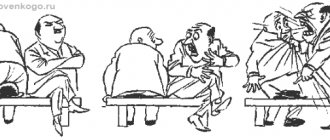The topic to which this article is devoted has been of concern to the global scientific community for several decades - it is directly related to the individual personal characteristics of people.
Everyone knows that the psyche of each person is unique. And this is connected both with the physical and biological characteristics of the organism, and with a complex of social characteristics. If we talk about biologically determined substructures, then, mainly, we need to consider temperament.
What is temperament?
Temperament implies the mental differences of people, which include the depth, intensity and stability of emotions, energy and pace of actions, emotional sensitivity and many other features of mental life. And the problem of temperament today remains controversial and unresolved. But even if we take into account all the diversity of approaches to its study, researchers agree that temperament is the biological foundation on which a person’s personality as a social being is based.
Temperament is a reflection of the dynamic aspects of behavior, which are mainly innate. Its properties are more stable than the properties of other mental characteristics of a person. And its most striking nuance is that the properties of the temperament of one particular person are not combined with each other by chance - they are interconnected naturally and form a certain conglomerate that characterizes the temperament.
To summarize: temperament must be considered as individually unique properties of the psyche that determine the dynamics of an individual’s mental activity; manifested equally in various activities, regardless of its motives, goals and content, and remaining unchanged already in adulthood, and also characterizing in the aggregate the type of temperament.
However, before considering the types of temperament and their features, it should be said that temperament cannot be bad or good, because Each type has its own advantages, and the efforts of any person should be aimed not at correcting its shortcomings, but at effectively applying its advantages in everyday life and activities.
"Hippocratic collection"
The Hippocratic Corpus that has come down to us (“Hippocratic Collection”) contains approx. 70 separate works, although it is clear that some of them are parts of once united works. In addition, there is a certain overlap of some works with others and repetitions. The collection contains both Hippocrates' own works and works by other authors written at different times. It has been suggested that the corpus represents the remains of a medical library rather than the works of authors belonging to the same school. Some of the writings demonstrate advanced scientific thought and skill in clinical observation and are therefore considered more “authentic” than others. But even on this issue there is no generally accepted opinion: there are researchers who generally doubt the existence of works belonging to Hippocrates himself.
Page from the Hippocratic collection
Hippocrates established the stages of development of diseases, laid the foundations of ancient surgery, developed methods for using bandages, treating fractures and dislocations, and introduced the concepts of anamnesis, prognosis, and etiology into medicine; divided people by temperament (sanguine, choleric, phlegmatic, melancholic). All medicine, in the views of Hippocrates, has a psychosomatic frame. This is medicine of both body and soul. Medicine is based on the harmony of man with nature and the cosmos.
Creation of typologies of temperament
Since ancient times, people have strived to understand and identify the typical mental characteristics of different people and unite them into a small number of generalizing models. It was these models that were called temperament types; moreover, they were very practical, because through them it was possible to predict the behavior of a person with a certain type of temperament in a specific life situation.
It is officially believed that the doctrine of temperament in general was created by the ancient Greek physician Hippocrates, who argued that people are distinguished by four main “body juices” - blood, phlegm, yellow bile and black bile. Following the teachings of Hippocrates, the equally famous physician of antiquity, Claudius Galen, created the first typology of temperaments of its kind and outlined it in his treatise “De Temperamentum”. According to his ideas, the type of temperament depends on what type of “juice” predominates in the human body. It was Galen who identified four known types of temperament: melancholic (black bile predominates), choleric (yellow bile predominates), phlegmatic (phlegm predominates) and sanguine (blood predominates). The presented concept has been of great importance to scientists for many centuries.
Biography
Hippocrates
Hippocrates received his initial medical education from his father, the physician Heraclides. For the purpose of scientific improvement in his youth, Hippocrates traveled a lot and studied medicine in different countries from the practice of local doctors and from votive tables that were hung in the walls of the temples of Asclepius.
- “The doctor is a philosopher; for there is not much difference between wisdom and medicine.” Hippocrates
The story of his life is little known; it is not even known exactly how many years Hippocrates lived. Some historians claim that he was 83 years old, while others say that he was 104. There are legends and stories relating to his biography, but they are of a legendary nature.
Hippocrates died around 370 BC. e. in Larissa, in Thessaly, where a monument was erected to him, but for thousands of years the “Hippocratic Oath” became the code of professional honor for all doctors.
Constitutional typologies of temperament
Subsequently, many typologies of temperament were put forward. But the greatest interest is caused by those among them where the properties of temperament, interpreted as innate or hereditary, are associated with individual characteristics in physique. Such typologies are called constitutional (typology by W. Sheldon, typology by E. Kretschmer and others). But, of course, such concepts have been criticized by psychologists. And their main drawback is that they underestimate, and often completely lose sight of, the influence of the environment and social conditions on the formation of a person’s psychological properties.
Story
Although a broad definition of temperament has been agreed upon, many temperament classification schemes have been developed, but there is still no consensus on them.
You may be interested in: Acceleration and velocity vectors. Acceleration and power. Directions of tangential and normal accelerations
Historically, the concept of “temperament” (originally “temperament” in Latin means “mixtures”). It was part of the theory of the four humors with their corresponding temperaments.
This historical concept has been explored by philosophers, psychologists, psychiatrists and psychophysiologists since the earliest times of psychological science, with theories proposed by Immanuel Kant, Hermann Lotze, Ivan Pavlov, Carl Jung, Gerardus Heymans and others. Their ideas were a development of the Hippocratic classification.
More recently, scientists seeking evidence for the biological basis of personality have further examined the relationship between temperament and neurotransmitter systems and character (defined in this context as aspects of personality development). However, biological correlations have proven difficult to confirm.
The theory of I. P. Pavlov
The fact that the course of mental processes and the behavior of an individual depends on the work of the nervous system, which plays a dominant role in the body, has been known for a long time. But the theory of the connection between temperament types and certain general properties of nervous processes was first proposed by the Russian physiologist I. P. Pavlov. It was subsequently developed by his followers.
In the understanding of Academician Pavlov, the type of nervous system is innate and is least subject to any changes under the influence of upbringing or environment. The properties of the nervous system, according to his ideas, form the physiological basis for temperament, which is a mental manifestation of the general type of the nervous system. Pavlov's subsequent studies on animals made it possible to identify types of nervous systems, which he proposed to extend to humans as well.
Additional classifications
Kagan also used two additional classifications: one for infants who were inactive but cried a lot (distressed), and one for those who were active but cried little (excited). At ages 14–17 years, these groups of children had different results, including some differences in central nervous system activity. Teens who were classified as high functioning when they were infants are more likely to be depressed in unfamiliar situations, have stern moods and anxiety in the future, and be more religious.
Components of temperament types
Every person has their own type of nervous system. Its manifestations (these are the characteristics of temperament) are an important part of individual psychological differences. The manifestations of any one type of temperament are very diverse; they can be traced in the manner of behavior, and also manifest themselves in the nature of mental activity, actions, sphere of feelings, motives, cognitive activity, characteristics of a person’s speech, etc.
To compose a psychological characteristic of one of the generally accepted types of temperament, they usually resort to the following basic properties:
- Emotional excitability - the speed of occurrence of an emotional reaction and the force of influence necessary for its occurrence;
- Introversion/extroversion – features of the dependence of a person’s reaction and activity. If they depend on external stimuli, then the person is an extrovert, if they depend on internal ones, then he is an introvert;
- Rate of reactions - the speed with which mental reactions and processes occur, speed of mind, rate of speech, etc.;
- Rigidity and plasticity – a person’s ability to adapt to external influences;
- Reactivity - the degree of involuntary reactions to internal or external stimuli of the same intensity;
- Activity – the intensity of a person’s impact on the outside world and the ability to overcome obstacles on the way to achieving a goal;
- The ratio of reactivity and activity is the dependence of human activity on internal or external circumstances, as well as beliefs, intentions, goals;
- Sensitivity is the level of the lowest intensity of external influence necessary for the occurrence of a mental reaction.
In connection with these properties, the outstanding Polish psychologist and doctor of science Jan Streliau gives the most popular characteristics of temperament types.
Literature
- Hippocrates. "Selected Books". M., Biomedgiz, 1936.
- Hippocrates. "Essays". M.-L., Medgiz, 1944, vol.II-III.
- Gusev I.S. Hippocrates. Donetsk: Donetsk region. 1995. ISBN 5-86938-095-2
- Volsky S.F. About Hippocrates and his teachings. From the lane in Russian language three of his most important and authentic books. St. Petersburg, 1840.
- Kozlov A. M., Kosarev I. I. Hippocrates and moral and ethical problems of medicine: Textbook. M.: I MMI. 1983.
- Jacques J. Hippocrates. / Per. from fr. (Series “Trace in History”). Rostov-on-Don: Phoenix. 1997.
- Petrov B.D. "Hippocrates". Clinical medicine, 1990, No. 9, p. 116-119.
Temperament types
According to J. Strelyau, the four main types of temperament are characterized by the following features:
Melancholic
A melancholic person is a person with high sensitivity and low level of reactivity. High sensitivity often leads to the fact that even a minor reason can cause tears. A melancholic person is painfully sensitive and very touchy. He has inexpressive movements and facial expressions, a quiet voice, poor movements, and a low energy level. As a rule, he is timid, unpersistent, unsure of himself, quickly gives up when doing things, has little ability to work and gets tired easily. The attention of such a person is unstable, all mental processes are slowed down. Most melancholic people are introverts.
Choleric
A choleric person is not particularly sensitive, has high activity and reactivity, and reactivity dominates, which is why he is quick-tempered, impatient, unrestrained, unbridled. Facial expressions, gestures and speech are rich and reflect the mood. His aspirations are stable, his interests are unshakable. The choleric person is persistent and sometimes has difficulty switching attention. In the vast majority of cases, choleric people are extroverts.
Phlegmatic person
A phlegmatic person is characterized by high activity, which dominates over low reactivity. He is insensitive and little emotional. External stimuli have a very weak effect on it; able to remain calm in unexpected situations. Also, phlegmatic people have slow and inexpressive movements, the same speech, and poor facial expressions. He has difficulty switching his attention, rebuilds habits and skills very slowly, but he has energy and high performance. Most phlegmatic people are introverts.
Sanguine
A sanguine person is a person with high reactivity, which is on par with activity. It is characterized by lively facial expressions, a wealth of gestures, a quick response to external circumstances, and ease of switching attention. Very sensitive, active, can work for a long time without getting tired. Disciplined, resourceful, has good ability to concentrate and self-control. His interests, moods and hobbies can change quickly. Almost all sanguine people are extroverts.
Sanguines
The word comes via French from the Italian sanguigna and originally from the Latin "sanguis" (red chalk). Each of the 4 types of Hippocratic classification is named after a substance, so do not be surprised at such a strange etymology.
The pigment used in sanguine sticks comes from red earth such as red ochre. Sanguine (chalk red) can also exist in several other colors such as orange, brown, brown, beige.
Summary
As noted above, none of the temperament types are either bad or good. In addition, a person cannot belong to only one single type - he can only have a predominant one, and the rest will be complementary. But, be that as it may, from the perspective of psychological science, types of temperament are only one of the ways of psychological assessment of a personality. You should also be aware that descriptions of temperaments may differ from one specialist to another and include many factors.
Origins
Historically, in the second century AD, the physician Galen described four temperaments (melancholic, phlegmatic, sanguine and choleric) based on the four humours, or bodily fluids. These became known as the four classical temperaments. In later history, Rudolf Steiner emphasized the importance of the four classical temperaments in elementary education, at a time when he believed that the influence of temperament on personality was strongest.
Neither Galen nor Steiner are generally applied to the modern study of temperament in the approaches of modern medicine or modern psychology.
Cholerics
People of this type are often leaders and masters of destiny. They strive to control situations, to be on top, to be the best.
This doesn't necessarily mean that they all want to reach the top of the corporate ladder or anything, or that they all want leadership roles, but in their day-to-day interactions with other people, they tend to be one-sided.
They use imperative, command language, framing things as orders rather than requests. Compare “bring me a drink” with “can I have a drink?” They'll probably use phrases like "sort it out", "get over yourself", "stop being such a wimp" and the like, or may start sentences with "look" or perhaps "look mate" or "listen" buddy" or things like that.
You might be interested:Anticline + syncline are folded mountains
They say things with confidence and confidence. Compare "X is so" with "maybe X is so, or something?"
They are firm and decisive in their approach to problems. They believe in “tough love” and try to “help” others by encouraging them to be their best selves.
They are more likely to tell someone they are trying to "help" that they are pathetic, expecting that person to say "no, I'm not pathetic, I'll show you!", as a choleric would actually respond to such thing.











